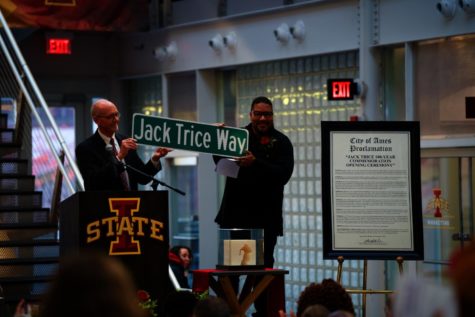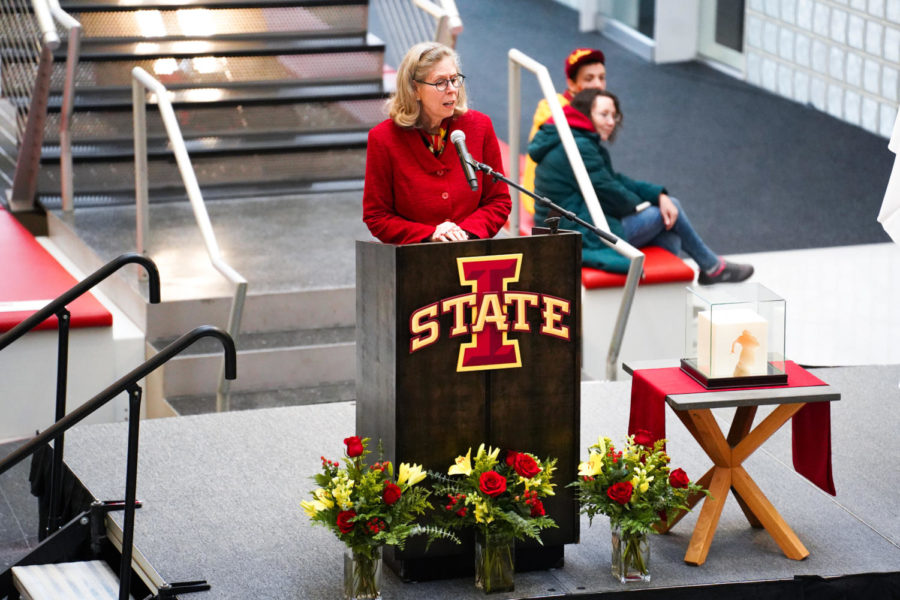‘Breaking Barriers’: New Jack Trice sculpture kicks off centennial celebration
President Wendy Wintersteen speaks during the Jack Trice Ceremony on Nov. 4.
The Iowa State community celebrated a new sculpture of Jack Trice at a ceremony from 4 to 5 p.m. Saturday. The “Breaking Barriers” statue is located on the north side of Jack Trice Stadium in Albaugh Family Plaza.
The ceremony was initially set to take place outside next to the sculpture but was moved inside to the Jacobson Athletic Building due to rain.
The ceremony kicked off the Jack Trice 100 Commemoration, a year-long celebration that will honor the life and legacy of Jack Trice. The festivities will end in the fall of 2023, 100 years after his death in October 1923.
As part of the commemoration, the section of South 4th Street between Beech Avenue and University Boulevard has been renamed Jack Trice Way.

Trice was Iowa State’s first African-American athlete and the namesake for the university’s football stadium, making it the only Division I stadium out of 144 Division I schools to be named after a Black athlete.
Despite the rainy weather, attendees nearly filled the ground floor of the Jacobson Athletic Building. Before and after the ceremony, conversations filled the space as community members shook hands, exchanged hugs and snacked on free food.
The ceremony saw several speakers, including George Trice, cousin of Jack Trice, and Anthony Johnson, an Iowa State football player who draws inspiration from Jack Trice. University President Wendy Wintersteen and Toyia Younger, senior vice president of student affairs and chair of the Jack Trice 100-Year Commemoration Committee, also spoke.
The speakers provided the audience with personal messages of inspiration, a brief history of Jack Trice, including a reading of his final letter and more.
By the end of the ceremony, George Trice walked away with a copy of the Jack Trice Way street sign, a small-scale replica of the Breaking Barriers sculpture, a framed rendering of the sculpture with the artist’s signature, an album of photographs and copies of Jack Trice’s academic records.
Additional centennial events will take place throughout the year, including a lecture series, archival presentations, and more.
Information about Jack Trice and the centennial celebration can be found on the Jack Trice 100 website.
The statue
“Breaking Barriers” is a bronze and concrete sculpture located in Albaugh Family Plaza near the north entrance of Jack Trice stadium. Seedorff Masonry workers used a crane to install the 200,000-pound sculpture piece by piece Oct. 25.
The sculpture, by internationally known artist Ivan Toth Depeña, features the silhouette of Jack Trice as an offensive lineman in a block of concrete. The top of the piece contains a fracture in the concrete to represent Jack Trice breaking through the barriers around him.

The sculpture is accompanied by six bronze cleat marks that lead into the silhouette, and each cleat mark carries the words “I Will.”
Visitors are encouraged to walk along the imprints into the sculpture’s silhouette to follow in Jack Trice’s footsteps.
“On a monumental scale, the sculpture intends to invoke the spirit of perseverance, memory/reflection and subsequent contemplation regarding our current state of unrest surrounding the subject of inequality,” Depeña said in a press release.
The story of Jack Trice
Jack Trice spent the night before his last college football game isolated from his teammates. He resided in the Curtis Hotel in Minneapolis, a separate hotel from his teammates, because officials at the team hotel refused to allow him to eat with the others.
In preparation for the day ahead, Jack Trice wrote a 133-word letter on a sheet of hotel stationery to express his thoughts about the day ahead.
In this letter, Jack Trice wrote the words “I will,” a phrase that has become tied to his legacy.

“The honor of my race, family and self are at stake,” Jack Trice wrote in his letter. “Everyone is expecting me to do big things. I will!”
The next day, in a game against Minnesota, Jack Trice fractured his collarbone but continued to play. Later in the game, he fell on his back and was trampled by several Minnesota players. He was taken to a local hospital but then allowed to return home to Ames. He died two days later from internal injuries. Though it has never been confirmed, several people speculate that Jack Trice was targeted for his skin color.
“I wish we could have seen what [Jack Trice] could have accomplished,” Gloria Betcher, city council member, English professor and lead of a Tracing Race research project. “He was a very talented track athlete and he wanted to work in animal husbandry. To have him die so young is a great loss.”
Jack Trice, born in Hiram, Ohio, first attended Iowa State College in 1922, a time when the Ku Klux Klan (KKK) was having a national resurgence.
After acquiring credits from a two-year non-collegiate agricultural program, he enrolled in animal husbandry. He intended to use his education to help farmers in the south improve their farming methods.
During his time at Iowa State, Jack Trice was an active member of Alpha Phi Alpha, one of many “Divine Nine” Greek communities on campus. He received good grades, according to the registrar’s records and was also a husband.
As a member of the Iowa State Cyclones football team and track team, he was the university’s first Black athlete.
“Jack understood the assignment, and he decided he desired nothing more than to represent his race in the classroom and on the field,” Younger said during the ceremony.
Ongoing impact
The story of Jack Trice continues to inspire current students and athletes, including Anthony Johnson, a senior in communication studies and an Iowa State football player.
“I resonate with Jack Trice so much because of how he responded to and how he challenges adversity,” Johnson said during the ceremony.
Johnson shared details of his own story, which involved growing up in a motel with eight people in two beds. While facing adversity and experiencing the temptation to quit or give up, Johnson looked to Jack Trice for inspiration.
Johnson is a team captain for the Cyclones football team and recently broke a record as the first player in Iowa State history to start 50 games. He is also on track to be the first in his family to graduate college.
“I took the Jack Trice ‘I Will’ as a challenge,” Johnson said during the ceremony. “I can stand before you today and successfully say ‘I did.’”
A legacy that continues
Members of the Trice family, including George Trice, his wife, his mother and his oldest son, were the first to walk through the sculpture’s silhouette. This first walk, originally scheduled for the ceremony, took place hours earlier during a break in the day’s rain at 11:30 a.m.
George Trice’s initial thoughts while walking through the sculpture related to the cold and rainy weather, but he was also struck by the fact that he was staring face-to-face with the legacy of his own family.
“You just hope you don’t fail,” George Trice said. “You hope that you hold up to the standards that they put in front of you, because you always want to follow in the footsteps of people who were great ahead of you.”

To continue to share Jack Trice’s legacy with others, George Trice started a foundation in his cousin’s name two years ago.
“We want to give back because that’s what Jack wanted to give people,” George Trice said. “I’m trying to keep his memory alive by giving people an opportunity to better themselves.”
The Trice Legacy Foundation is set to give away its first scholarship in 2023 to a student from East Tech High School in Cleveland, Ohio, the school Jack Trice graduated from.
“The story of Jack Trice is the story of Iowa State,” Younger said. “It really speaks to our mission that continues today, that our land grant mission is that we’re going to be open for all.”
By the end of the commencement ceremony, the rain outside had paused. As visitors trickled out of the Jacobson Athletic Building, groups of people took turns following Jack Trice’s “I Will” footsteps into the Breaking Barriers sculpture.
Your donation will support the student journalists of the Iowa State Daily. Your contribution will allow us to purchase equipment, send our student journalists to conferences and off-set their cost of living so they can continue to do best-in-the-nation work at the Iowa State Daily.










